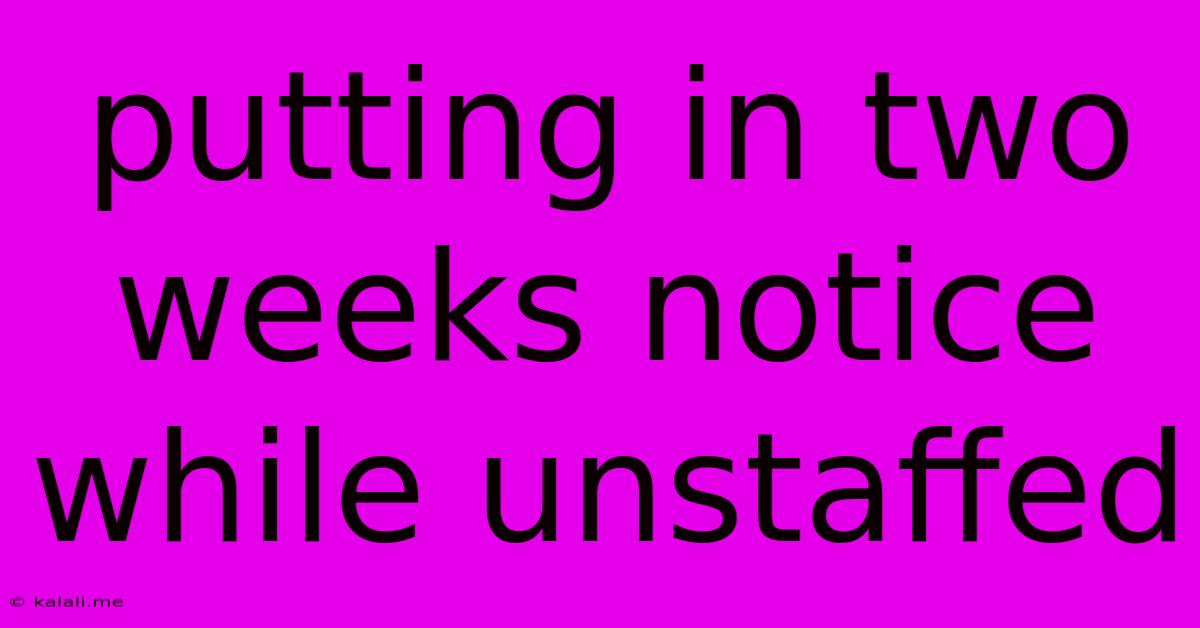Putting In Two Weeks Notice While Unstaffed
Kalali
Jun 03, 2025 · 3 min read

Table of Contents
Putting in Your Two Weeks' Notice When Your Team is Understaffed: A Guide to Graceful Exits
Giving your two weeks' notice is never easy, but it's especially tricky when your team is already understaffed. Leaving a company short-handed can feel incredibly guilt-inducing, but handling the situation with grace and professionalism is crucial for maintaining your reputation and minimizing disruption. This guide will help you navigate this delicate situation.
Meta Description: Leaving a job when your team is understaffed is tough. This guide provides strategies for giving your two weeks' notice gracefully, minimizing disruption, and maintaining positive professional relationships. Learn how to offer support during the transition and leave a lasting positive impression.
Understanding the Challenges
Before submitting your resignation, acknowledge the challenges your departure presents. An understaffed team means increased workloads for remaining employees. Your absence will likely create significant pressure and potentially impact project deadlines and overall team morale. Recognizing this upfront helps you approach the situation with empathy and a proactive mindset.
Strategies for a Smooth Transition
1. Timing is Everything: While a formal two-week notice is standard, consider the specific circumstances. If your team is critically understaffed, a slightly longer notice period might be beneficial. This allows for more thorough handover of responsibilities and reduces immediate pressure on your colleagues. Discuss this possibility with your manager during your resignation conversation.
2. Detailed Handover Plan: The most important aspect of leaving a short-staffed team is creating a comprehensive handover plan. This plan should detail every task, project, and responsibility you manage, including:
- Project Documentation: Gather all relevant documents, spreadsheets, and notes related to ongoing projects. Ensure this information is easily accessible and well-organized.
- Contact Information: Provide a detailed list of all key contacts, including clients, vendors, and internal collaborators.
- Process Documentation: Clearly outline any processes or procedures you've developed or implemented.
- Training and Support: Offer to train your colleagues on your responsibilities to the best of your ability. Schedule training sessions to minimize disruption.
3. Offer Assistance Beyond the Two Weeks: Even after your official last day, consider offering limited assistance if possible. This could be answering clarifying questions via email or providing remote support for critical projects. This demonstrates your commitment to a smooth transition and maintains positive professional relationships.
4. Honest and Open Communication: Be upfront and honest with your manager about the team's understaffing. Explain your concerns and your commitment to minimizing disruption during your departure. A frank and open conversation allows for collaborative solutions and demonstrates your professionalism.
5. Focus on Solutions, Not Problems: Instead of dwelling on the negative impacts of your departure, actively work with your manager to find solutions. This might involve prioritizing tasks, identifying potential replacements, or suggesting temporary solutions to bridge the gap.
6. Maintain Professionalism: Even if you're frustrated or stressed, maintain a professional demeanor throughout the entire process. Avoid gossiping or making negative comments about the company or your colleagues. Your reputation is crucial, even after you've left.
After You Leave
Remember to keep your professional network active even after you've left the company. Staying in contact with colleagues can lead to future collaborations or opportunities. Leaving on positive terms strengthens your reputation and can have long-term professional benefits.
By carefully planning your departure and demonstrating a commitment to a smooth transition, you can mitigate the negative impacts of leaving an understaffed team and leave a lasting positive impression. Remember, professionalism, empathy, and proactive problem-solving are key to navigating this delicate situation.
Latest Posts
Latest Posts
-
Ac Not Able To Keep Up
Jun 05, 2025
-
How To Ask Out A Colleague
Jun 05, 2025
-
Stole From Sub Contractors With 9 Bankruptices
Jun 05, 2025
-
Super Suit Designer Who Insists No Capes
Jun 05, 2025
-
How Long Is Life In Prison In Ga
Jun 05, 2025
Related Post
Thank you for visiting our website which covers about Putting In Two Weeks Notice While Unstaffed . We hope the information provided has been useful to you. Feel free to contact us if you have any questions or need further assistance. See you next time and don't miss to bookmark.